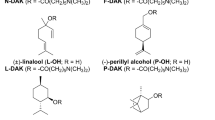Abstract
Piperazinylalkyl ester prodrugs (4a–5d) of 6-methoxy-2-naphthylacetic acid (6-MNA) (1) were synthesized and evaluated in vitro for the purpose of percutaneous drug delivery. These ionizable prodrugs exhibited varying aqueous solubilities and lipophilicities depending on the pH of the medium. The prodrugs (4a–5c) showed higher aqueous solubility and similar lipophilicity at pH 5.0 and lower aqueous solubility and higher lipophilicity at pH 7.4 in comparison to 6-MNA. The chemical and enzymatic hydrolyses of the prodrugs was investigated in aqueous buffer solutions (pH 5.0 and 7.4) and in 80% human serum (pH 7.4) at 37°C. The prodrugs showed moderate chemical stability (t 1/2 = 6–60 h) but got readily hydrolyzed enzymatically to 6-MNA with half-life ranging from 10–60 min. In the in vitro permeation study using rat skin, the flux of 6-MNA and the prodrugs was determined in aqueous buffers of pH 5.0 and 7.4. The prodrug (5b) showed 7.9- and 11.2-fold enhancement in skin permeation compared to 6-MNA (1) at pH 5.0 and 7.4, respectively. It was concluded that the parent NSAIDs having favorable pharmacokinetic and pharmacodynamic properties coupled with increased skin permeability of their prodrugs could give better options for the treatment of rheumatic diseases.





Similar content being viewed by others
REFERENCES
Rautio J, Nevalainen T, Taipale H, Vepsäläinen J, Gynther J, Laine K, et al. Piperazinylalkyl prodrugs of naproxen improve in vitro skin permeation. Eur J Pharm Sci. 2000;11:157–63.
Nagarsenker MS, Amin L, Date AA. Potential of cyclodextrin complexation and liposomes in topical delivery of ketorolac: in vitro and in vivo evaluation. AAPS PharmSciTech. 2008;9:1165–70.
Suh H, Jun HW, Dzimianski MT, Lu GW. Pharmacokinetic and local tissue disposition studies of naproxen following topical and systemic administration in dogs and rats. Biopharm Drug Disp. 1997;18:623–33.
Mikulak SA, Vangsness CT, Nimni ME. Transdermal delivery and accumulation of indomethacin in subcutaneous tissues in rats. J Pharm Pharmacol. 1998;50:153–8.
Rautio J, Nevalainen T, Taipale H, Vepsäläinen J, Gynther J, Laine K, et al. Synthesis and in vitro evaluation of novel morpholinyl and methylpiperazinyl acyloxyalkyl prodrugs of 2-(6-methoxy-2-naphthyl)propionic acid (Naproxen) for topical drug delivery. J Med Chem. 2000;43:1489–94.
Moreira TS, de Sousa VP, Pierre MB. A novel transdermal delivery system for the anti-inflammatory lumiracoxib: influence of oleic acid on in vitro percutaneous absorption and in vivo potential cutaneous irritation. AAPS PharmSciTech. 2010;11:621–9.
Duangjit S, Opanasopit P, Rojanarata T, Ngawhirunpat T. Evaluation of meloxicam-loaded cationic transfersomes as transdermal drug delivery carriers. AAPS PharmSciTech. 2013;14:133–40.
Barakat NS. Evaluation of glycofurol-based gel as a new vehicle for topical application of naproxen. AAPS PharmSciTech. 2010;11:1138–46.
Barry BW. Mode of action of penetration enhancers in human skin. J Control Rel. 1987;6:85–97.
Fang L, Numajiri S, Kobayashi D, Morimoto Y. The use of complexation with alkanolamines to facilitate skin permeation of mefenamic acid. Int J Pharm. 2003;262:13–22.
Amjad Q, Soraya A. Synthesis of piperazinylalkyl ester prodrugs of ketorolac and their In vitro evaluation for transdermal delivery. Drug Dev Ind Pharm. 2008;34:1054–63.
Altman RD. New guidelines for topical NSAIDs in the osteoarthritis treatment paradigm. Curr Med Res Opin. 2010;26:2871–6.
Komatsu T, Sakurada T. Comparison of the efficacy and skin permeability of topical NSAID preparations used in Europe. Eur J Pharm Sci. 2012;47:890–5.
Davies NM. Clinical pharmacokinetics of nabumetone. The dawn of selective cyclo-oxygenase-2 inhibition? Clin Pharmacokinet. 1997;33:404–16.
Friedel HA, Langtry HD, Buckley MM. Nabumetone: a reappraisal of its pharmacology and therapeutic use in rheumatic diseases. Drugs. 1993;45:131–56.
Gu L, Dunn J, Dvorak C. Preformulation prodrug research-chemical and enzymatic hydrolysis kinetics of the glycerol, glycolic acid and morpholino ethyl ester derivatives of a developmental analgesic agent (RS-82917). Drug Dev Ind Pharm. 1989;15:209–21.
Tammara VK, Narurkar MM, Crider AM, Khan MA. Synthesis and evaluation of morpholinoalkyl ester prodrugs of indomethacin and naproxen. Pharm Res. 1993;10:1191–9.
Lobo S, Li H, Farhan N, Yan G. Evaluation of diclofenac prodrugs for enhancing transdermal delivery. Drug Dev Ind Pharm. 2014;40:425–32.
Walters KA, editor. Dermatological and transdermal formulations. New York: Marcel Dekker; 2002. p. 119.
Arsenijevic L, Arsenijevic V, Horeau A, Jacques J. Synthesis of 2-acetyl-6-methoxynaphthalene. Org syn. 1998;6:34–6.
Furniss BS, Hannaford JH, Smith PWG, Tachell AR. Vogel’s text book of practical organic chemistry, 5th edition. Singapore: Longman; 1996. p. 987–1054.
Akre KP, Gaikar VG. Recovery of 1,4-dimethyl piperazine from aqueous solutions using polymeric adsorbent and ion-exchange resins. Sep Sci Technol. 2006;41:1593–617.
Nasr M, Mansour S, Mortada ND, El Shamy AA. Lipospheres as carriers for topical delivery of aceclofenac: preparation, characterization and in vivo evaluation. AAPS PharmSciTech. 2008;9:154–62.
Kumbhar D, Wavikar P, Vavia P. Niosomal gel of lornoxicam for topical delivery: in vitro assessment and pharmacodynamic activity. AAPS PharmSciTech. 2013;14:1072–82.
Declaration of Interest
The authors report no conflicts of interest. The authors alone are responsible for the content and writing of this article.
Author information
Authors and Affiliations
Corresponding author
Electronic supplementary material
Below is the link to the electronic supplementary material.
ESM 1
(DOCX 12724 kb)
Rights and permissions
About this article
Cite this article
Pawar, V., Thosani, R., Kanhed, A. et al. Potential of Piperazinylalkylester Prodrugs of 6-Methoxy-2-Naphthylacetic Acid (6-MNA) for Percutaneous Drug Delivery. AAPS PharmSciTech 16, 518–527 (2015). https://doi.org/10.1208/s12249-014-0240-6
Received:
Accepted:
Published:
Issue Date:
DOI: https://doi.org/10.1208/s12249-014-0240-6




